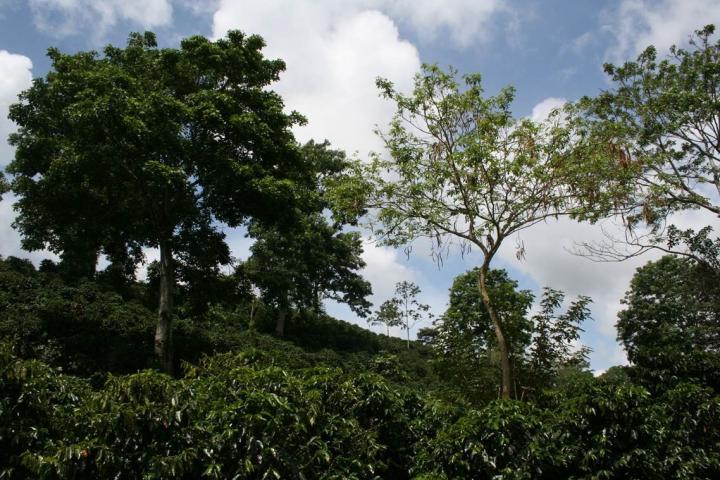Plants with jobs

Plant diversity in agroecosystems -- coffee agroforestry in Central America. Credit: Adam Martin - U of T Scarborough
In a paper published this week in the Journal of Applied Ecology, Marney Isaac, Canada Research Chair in Agroecosystems and Development and her co-author Adam Martin, describe how an approach known as “functional trait-based ecology” can apply to agricultural research and management. Rather than analyzing genetics or measuring yields, functional-trait research focuses on how plants both respond to and affect changes to their environment.
“Historically, the way we try to understand how crop diversity influences yield and the environment has been limited,” says Isaac. “We propose a rigorous approach rooted in ecological science to measure agricultural impacts.”
Isaac and Martin's framework can help answer many questions like: How do certain species cycle nutrients? Can they repel certain pests? Do they mitigate the effects of drought?
“Environmental changes and agricultural practices can affect the size of crops, their leaf and root characteristics, and their reproductive patterns,” says Isaac. “Trait-based approaches tell us about the causes and consequences of these changes – not just in terms of yield, but also in terms of how crops interact with other plants, insects, microbes, and their surrounding environment.”
In other ecological contexts, functional-trait research has a long and successful track record, but it is only just starting to find purchase in agriculture.
“Trait-based studies have been instrumental in advancing our understanding of ecological patterns in natural and experimental ecosystems,” says Martin. “We wanted to create a blueprint for applying this approach to agricultural systems.”
“Commodity crops often result in heavily intensified monocultures where you have just one crop species covering a whole plot of land,” says Martin. “Monocultures can result in terrible environmental conditions, but they tend to maximize yield.”
Monocultures can be more vulnerable and less resilient to drought, disease, invasive species and herbivorous pests. But an effort solely aimed at increasing species diversity might not solve the problem. The authors cite the example of coffee plantations, which can become “Rainforest Alliance Certified” if they diversify sufficiently.
“You may have 15 different tree species and three crop species on your farm,” says Martin. “This is a great start, but functional ecology could improve such certifications. Our framework can provide data about how to choose species that play complementary roles that better foster resilience and sustainability.”
Martin and Isaac hope their framework will help researchers consolidate functional-trait data about the world's most common crops.
“Once consolidated, we expect this data can help us better understand how agro-ecosystems function, and ideally inform sustainable agricultural management strategies,” says Isaac.
###
Funding for this research comes from Isaac's Canada Research Chair as well as from a Discovery Grant from the Natural Sciences and Engineering Research Council of Canada.
Media Contact
All latest news from the category: Life Sciences and Chemistry
Articles and reports from the Life Sciences and chemistry area deal with applied and basic research into modern biology, chemistry and human medicine.
Valuable information can be found on a range of life sciences fields including bacteriology, biochemistry, bionics, bioinformatics, biophysics, biotechnology, genetics, geobotany, human biology, marine biology, microbiology, molecular biology, cellular biology, zoology, bioinorganic chemistry, microchemistry and environmental chemistry.
Newest articles

A ‘language’ for ML models to predict nanopore properties
A large number of 2D materials like graphene can have nanopores – small holes formed by missing atoms through which foreign substances can pass. The properties of these nanopores dictate many…

Clinically validated, wearable ultrasound patch
… for continuous blood pressure monitoring. A team of researchers at the University of California San Diego has developed a new and improved wearable ultrasound patch for continuous and noninvasive…

A new puzzle piece for string theory research
Dr. Ksenia Fedosova from the Cluster of Excellence Mathematics Münster, along with an international research team, has proven a conjecture in string theory that physicists had proposed regarding certain equations….



